Legal challenges mount to new round of Navy training permits
Effects of Noise on Wildlife, Ocean, Sonar Comments Off on Legal challenges mount to new round of Navy training permitsIn December, the Navy’s current five-year plan for training and testing activities around Hawaii and off the southern California coast were approved by NOAA regulators, covering the years 2014-2018. The approval authorized incidental takes of marine mammals, including both widespread behavioral changes and close-range injuries and some deaths, as a result of sound exposure from sonar and explosives, as well as ship strikes.
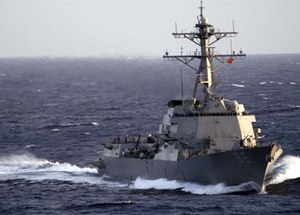 Immediately after NOAA’s approval, environmental organizations filed suit in federal court in Hawaii, and this week, other organizations filed suit in a San Francisco federal court (the Navy pushed back in a brief statement). It’s unclear from early press coverage how much overlap there is between the two; the Hawaii suit, led by Earthjustice, initially named just NOAA, but has been amended to also name the Navy as a defendant. The San Francisco suit, led by the NRDC, targets NOAA, charging that federal regulators did not use “best available science” and that their finding of “negligible impact” violates the Marine Mammal Protection Act.
Immediately after NOAA’s approval, environmental organizations filed suit in federal court in Hawaii, and this week, other organizations filed suit in a San Francisco federal court (the Navy pushed back in a brief statement). It’s unclear from early press coverage how much overlap there is between the two; the Hawaii suit, led by Earthjustice, initially named just NOAA, but has been amended to also name the Navy as a defendant. The San Francisco suit, led by the NRDC, targets NOAA, charging that federal regulators did not use “best available science” and that their finding of “negligible impact” violates the Marine Mammal Protection Act.
At issue in both suits is the shockingly large numbers of animals that are permitted to be affected, amounting to nearly 10 million behavioral responses, the potential for 2000 permanent injuries (including hearing impairment), and 155 deaths over the course of five years. “This is an unprecedented level of harm,” Zak Smith, an attorney with the Natural Resources Defense Council, said. “In order to authorize these impacts on marine mammals, the service had to turn its back on the best available science.”
It’s important to note that while sonar has been the focus of most public concern, explosions during testing and training are predicted to cause most of the injuries and deaths. The Navy and NMFS consider the estimates to be extremely cautious (ie far higher than actual likely impacts) for a number of reasons; see the bullet list in this earlier AEI post for more on why.
NRDC, Earthjustice, and the other plaintiffs continue to stress that the Navy can and should limit its activities in areas and times of particular biological importance to marine species; the lack of such “spatio-temporal restrictions” has been a bone of contention for many years, and this time, as in past rounds of permitting, the Navy and NMFS determined that such restrictions would yield little biological benefit. A largely similar lawsuit filed in 2012, challenging NOAA permits for Navy training in the Pacific Northwest, ended up in a split decision, with the “best available science” ruling going against NOAA, but the large takes challenge (including the lack of exclusion zones, as well as faulty negligible impact ruling) falling short, with the court approving of NOAA’s analysis and actions.
UPDATE, 2/10/14: See this article from NRDC, outlining their reasons for this lawsuit and how it fits in with their 20-year history of focusing on ocean noise issues.

 One study is further along, having
One study is further along, having  She said the sound of “bait balls” of prey, such as schools of fish, could be greatly heightened when a feeding frenzy involving larger fish and seabirds broke out. Dr Constantine said whales had been observed swimming rapidly from over a kilometre away toward prey aggregations, “so we’re very interested to find out if there are specific acoustic cues they home in on”.
She said the sound of “bait balls” of prey, such as schools of fish, could be greatly heightened when a feeding frenzy involving larger fish and seabirds broke out. Dr Constantine said whales had been observed swimming rapidly from over a kilometre away toward prey aggregations, “so we’re very interested to find out if there are specific acoustic cues they home in on”.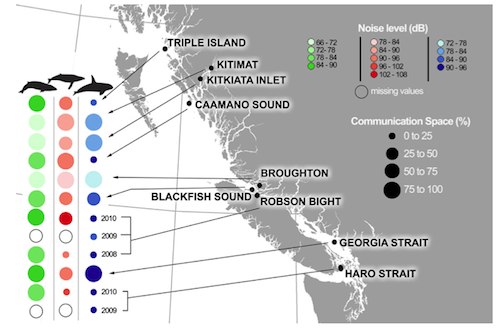 (noise levels and communication space in median noise conditions)
(noise levels and communication space in median noise conditions) For the first day and a half, larvae exposed to airgun noise showed significant developmental delays. At close to two days, the noise-exposed group appeared to be nearly as likely to be fully developed as the control group (upper right chart). But, after passing the 48-hour mark, as the larvae moved into the next stage of development, those in noise lagged again; at 66 hours, all of the control larvae had completed the D-veligar development, while a large proportion of those exposed to noise did not complete this transition. In addition, a significant proportion of the noise-exposed larvae began exhibiting physical abnormalities (localized bulges in the soft body of the larvae, but not in the shell). By the end of the study, at 90 hours, an average of 46% of noise-exposed larvae showed malformations, ranging from 27%-91% in the four flasks being independently analyzed. (Ed. Note: I’ve reproduced five of the seven charts here, omitting samplings at 54hrs and 90hrs for the sake of better readability.)
For the first day and a half, larvae exposed to airgun noise showed significant developmental delays. At close to two days, the noise-exposed group appeared to be nearly as likely to be fully developed as the control group (upper right chart). But, after passing the 48-hour mark, as the larvae moved into the next stage of development, those in noise lagged again; at 66 hours, all of the control larvae had completed the D-veligar development, while a large proportion of those exposed to noise did not complete this transition. In addition, a significant proportion of the noise-exposed larvae began exhibiting physical abnormalities (localized bulges in the soft body of the larvae, but not in the shell). By the end of the study, at 90 hours, an average of 46% of noise-exposed larvae showed malformations, ranging from 27%-91% in the four flasks being independently analyzed. (Ed. Note: I’ve reproduced five of the seven charts here, omitting samplings at 54hrs and 90hrs for the sake of better readability.)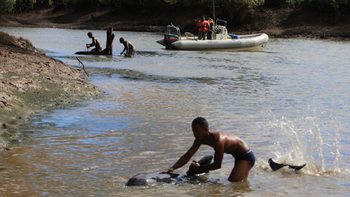 For the first time, a mass stranding appears to have been triggered by a relatively high-frequency mapping sonar; most previous strandings (though rare) have been associated with mid-frequency military sonars. An international, independent scientific review panel (ISRP) of five well-known marine mammal researchers has concluded that a 2008 stranding event on the northwest coast of Madagascar was likely precipitated by an avoidance response to a multi-beam echo-sounder system (MBES) being used to map the seafloor.
For the first time, a mass stranding appears to have been triggered by a relatively high-frequency mapping sonar; most previous strandings (though rare) have been associated with mid-frequency military sonars. An international, independent scientific review panel (ISRP) of five well-known marine mammal researchers has concluded that a 2008 stranding event on the northwest coast of Madagascar was likely precipitated by an avoidance response to a multi-beam echo-sounder system (MBES) being used to map the seafloor. Acoustic modeling suggests that the whales would have been able to hear the MBES signals for at least 30km from the survey vessel, to near the island seen on the map to the right, 25km offshore, at which point they apparently continued moving toward shore until straying into the stranding zone. Why the animals continued moving inshore after the sonar was no longer audible is unclear. This is a species that normally lives only in deep waters; once the whales moved past the cliff near the survey area and into shallow shelf waters, they may have been quite confused, and further behavioral anomalies (including ending up in the estuary) may be unrelated to the survey sounds.
Acoustic modeling suggests that the whales would have been able to hear the MBES signals for at least 30km from the survey vessel, to near the island seen on the map to the right, 25km offshore, at which point they apparently continued moving toward shore until straying into the stranding zone. Why the animals continued moving inshore after the sonar was no longer audible is unclear. This is a species that normally lives only in deep waters; once the whales moved past the cliff near the survey area and into shallow shelf waters, they may have been quite confused, and further behavioral anomalies (including ending up in the estuary) may be unrelated to the survey sounds.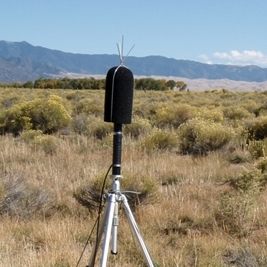 For over a decade, the National Park Service has been on the
For over a decade, the National Park Service has been on the 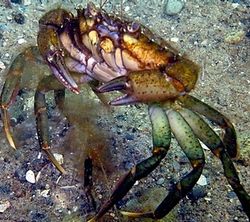 Add crabs, and perhaps by extension other crustaceans, to the list of animals negatively affected by shipping noise in the world’s oceans.
Add crabs, and perhaps by extension other crustaceans, to the list of animals negatively affected by shipping noise in the world’s oceans. 
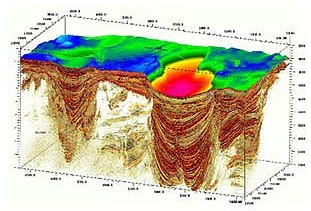 And, the Bureau of Ocean Energy and Management will develop new standards to assure that airgun surveys are not unnecessarily duplicative. Dozens of surveys take place every year in the Gulf, with repeat surveys sometimes needed to assess reservoir depletion, and as new and improved imaging capabilities are developed; often, survey results are considered proprietary, especially prior to bidding on leases.
And, the Bureau of Ocean Energy and Management will develop new standards to assure that airgun surveys are not unnecessarily duplicative. Dozens of surveys take place every year in the Gulf, with repeat surveys sometimes needed to assess reservoir depletion, and as new and improved imaging capabilities are developed; often, survey results are considered proprietary, especially prior to bidding on leases.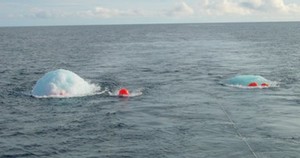 “Today’s agreement is a landmark for marine mammal protection in the Gulf,” said Michael Jasny, director of NRDC’s Marine Mammal Protection Project. “For years this problem has languished, even as the threat posed by the industry’s widespread, disruptive activity has become clearer and clearer.”
“Today’s agreement is a landmark for marine mammal protection in the Gulf,” said Michael Jasny, director of NRDC’s Marine Mammal Protection Project. “For years this problem has languished, even as the threat posed by the industry’s widespread, disruptive activity has become clearer and clearer.”
 Except in winter. The groundbreaking Travel Management Rule specifically exempted snowmobiles from being subject to the limits contained in each forest’s local Travel Management Plan. The reasoning was that many of the damaging aspects of unfettered ORV use were less relevant in winter; in particular, damage to vegetation and streambeds, and all the related risks of increased erosion. These impacts are indeed significantly less in winter, though some soil compaction can occur beneath snowmobile trails over meadows.
Except in winter. The groundbreaking Travel Management Rule specifically exempted snowmobiles from being subject to the limits contained in each forest’s local Travel Management Plan. The reasoning was that many of the damaging aspects of unfettered ORV use were less relevant in winter; in particular, damage to vegetation and streambeds, and all the related risks of increased erosion. These impacts are indeed significantly less in winter, though some soil compaction can occur beneath snowmobile trails over meadows.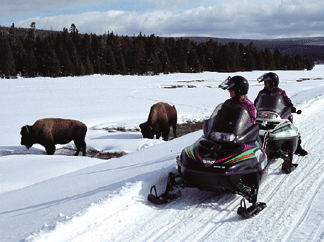 In the years since, the two-year extension of the Bush-era temporary plan stretched to four, and finally the new proposed plan has been released. In truth, it isn’t all that different than the Bush plan in terms of total numbers of snowmobiles and snowcoaches, though it tweaks a few elements in ways that may reduce some impacts, especially air quality, over time. It seems likely that the noise impacts will be roughly similar to those documented in a series of studies we
In the years since, the two-year extension of the Bush-era temporary plan stretched to four, and finally the new proposed plan has been released. In truth, it isn’t all that different than the Bush plan in terms of total numbers of snowmobiles and snowcoaches, though it tweaks a few elements in ways that may reduce some impacts, especially air quality, over time. It seems likely that the noise impacts will be roughly similar to those documented in a series of studies we 
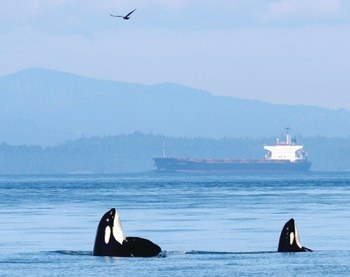 In the wake of
In the wake of 
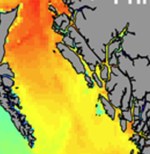 That’s an inland waterway that heads up to Kitimat, the proposed site of a major new port, the Northern Gateway, which would serve as the primary port for shipping tar sands oil to Asia. An annual total 220 super-tankers would head though that currently mostly-yellow zone, all the way up that long, narrow channel that points to the upper right hand corner of this close-up (and leave again
That’s an inland waterway that heads up to Kitimat, the proposed site of a major new port, the Northern Gateway, which would serve as the primary port for shipping tar sands oil to Asia. An annual total 220 super-tankers would head though that currently mostly-yellow zone, all the way up that long, narrow channel that points to the upper right hand corner of this close-up (and leave again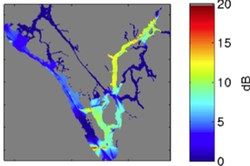 A second study by the same research team, led by Christine Erbe, took a close look at current and likely increases in shipping noise, should Northern Gateway go forward, and what they found is not reassuring. Noise levels will increase by up to 6dB in the approach lanes in Caamano Sound, and by 10-12dB in the narrow fjord into Kitimat (see map on right). In the western channel (the wider approach), where sound would likely increase 3-6dB (representing a doubling to quadrupling of sound energy), Humpbacks would hear tankers and their accompanying two tugboats for 43% of daylight hours, and orcas (due to thier higher-frequency hearing, less intruded upon by low-frequency ship noise) would hear the tankers 25% of the time. Fewer whales venture all the way up the fjords, but some would likely be present in the bend in the route, where noise levels would increase by 10dB, representing a 10-fold increase in sound energy.
A second study by the same research team, led by Christine Erbe, took a close look at current and likely increases in shipping noise, should Northern Gateway go forward, and what they found is not reassuring. Noise levels will increase by up to 6dB in the approach lanes in Caamano Sound, and by 10-12dB in the narrow fjord into Kitimat (see map on right). In the western channel (the wider approach), where sound would likely increase 3-6dB (representing a doubling to quadrupling of sound energy), Humpbacks would hear tankers and their accompanying two tugboats for 43% of daylight hours, and orcas (due to thier higher-frequency hearing, less intruded upon by low-frequency ship noise) would hear the tankers 25% of the time. Fewer whales venture all the way up the fjords, but some would likely be present in the bend in the route, where noise levels would increase by 10dB, representing a 10-fold increase in sound energy.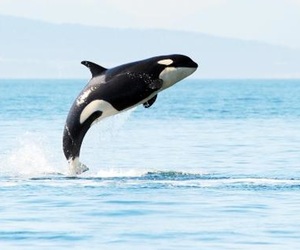 NOAA Fisheries announced on Monday that it would review the status of the southern resident population of killer whales, in response to a delisting petition from California farmers. In addition to boat noise, a decrease in salmon runs is a key driver of reduced orca populations, and protection plans for the orcas include protections for salmon, including maintaining river flows. The farmers claim this is denying them the water they need. The heart of the petition is a challenge to NOAA’s determination that this local population is genetically distinct and deserving protection, although the species as a whole is not threatened.
NOAA Fisheries announced on Monday that it would review the status of the southern resident population of killer whales, in response to a delisting petition from California farmers. In addition to boat noise, a decrease in salmon runs is a key driver of reduced orca populations, and protection plans for the orcas include protections for salmon, including maintaining river flows. The farmers claim this is denying them the water they need. The heart of the petition is a challenge to NOAA’s determination that this local population is genetically distinct and deserving protection, although the species as a whole is not threatened.